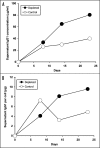Inhibitory effects of persistent apoptotic cells on monoclonal antibody production in vitro: simple removal of non-viable cells improves antibody productivity by hybridoma cells in culture
- PMID: 20068393
- PMCID: PMC2726608
- DOI: 10.4161/mabs.1.4.9124
Inhibitory effects of persistent apoptotic cells on monoclonal antibody production in vitro: simple removal of non-viable cells improves antibody productivity by hybridoma cells in culture
Abstract
Cells undergoing apoptosis in vivo are rapidly detected and cleared by phagocytes. Swift recognition and removal of apoptotic cells is important for normal tissue homeostasis and failure in the underlying clearance mechanisms has pathological consequences associated with inflammatory and auto-immune diseases. Cell cultures in vitro usually lack the capacity for removal of non-viable cells because of the absence of phagocytes and, as such, fail to emulate the healthy in vivo micro-environment from which dead cells are absent. While a key objective in cell culture is to maintain viability at maximal levels, cell death is unavoidable and non-viable cells frequently contaminate cultures in significant numbers. Here we show that the presence of apoptotic cells in monoclonal antibody-producing hybridoma cultures has markedly detrimental effects on antibody productivity. Removal of apoptotic hybridoma cells by macrophages at the time of seeding resulted in 100% improved antibody productivity that was, surprisingly to us, most pronounced late on in the cultures. Furthermore, we were able to recapitulate this effect using novel super-paramagnetic Dead-Cert Nanoparticles to remove non-viable cells simply and effectively at culture seeding. These results (1) provide direct evidence that apoptotic cells have a profound influence on their non-phagocytic neighbors in culture and (2) demonstrate the effectiveness of a simple dead-cell removal strategy for improving antibody manufacture in vitro.
Figures





Similar articles
-
A fibrous-bed bioreactor for continuous production of monoclonal antibody by hybridoma.Adv Biochem Eng Biotechnol. 2004;87:61-96. doi: 10.1007/b94364. Adv Biochem Eng Biotechnol. 2004. PMID: 15217104 Review.
-
Control of redox potential in hybridoma cultures: effects on MAb production, metabolism, and apoptosis.J Ind Microbiol Biotechnol. 2012 Aug;39(8):1189-98. doi: 10.1007/s10295-012-1125-x. Epub 2012 Apr 17. J Ind Microbiol Biotechnol. 2012. PMID: 22526329
-
Induction of apoptosis in oxygen-deprived cultures of hybridoma cells.Cytotechnology. 1994;15(1-3):117-28. doi: 10.1007/BF00762386. Cytotechnology. 1994. PMID: 7765924
-
Rapamycin reduces hybridoma cell death and enhances monoclonal antibody production.Biotechnol Bioeng. 2001;76(1):1-10. doi: 10.1002/bit.1020. Biotechnol Bioeng. 2001. PMID: 11400101
-
Microenvironmental influences of apoptosis in vivo and in vitro.Apoptosis. 2010 Sep;15(9):1029-49. doi: 10.1007/s10495-010-0485-9. Apoptosis. 2010. PMID: 20237956 Review.
Cited by
-
Immune heterogeneity in neuroinflammation: dendritic cells in the brain.J Neuroimmune Pharmacol. 2013 Mar;8(1):145-62. doi: 10.1007/s11481-012-9414-8. Epub 2012 Nov 1. J Neuroimmune Pharmacol. 2013. PMID: 23114889 Free PMC article. Review.
-
Microfluidic Cell Retention Device for Perfusion of Mammalian Suspension Culture.Sci Rep. 2017 Jul 27;7(1):6703. doi: 10.1038/s41598-017-06949-8. Sci Rep. 2017. PMID: 28751635 Free PMC article.
-
Time-Resolved Study of Nanoparticle Induced Apoptosis Using Microfabricated Single Cell Arrays.Microarrays (Basel). 2016 Apr 15;5(2):8. doi: 10.3390/microarrays5020008. Microarrays (Basel). 2016. PMID: 27600074 Free PMC article.
-
Repression of Factor VIII Inhibitor Development with Apoptotic Factor VIII-expressing Embryonic Stem Cells.Hematol Rep. 2013 Jul 1;5(2):30-3. doi: 10.4081/hr.2013.e9. Print 2013 Jun 28. Hematol Rep. 2013. PMID: 23888245 Free PMC article.
-
Phenotypic drug profiling in droplet microfluidics for better targeting of drug-resistant tumors.Lab Chip. 2015 Dec 7;15(23):4441-50. doi: 10.1039/c5lc00923e. Lab Chip. 2015. PMID: 26456240 Free PMC article.
References
-
- Lauber K, Bohn E, Krober SM, Xiao YJ, Blumenthal SG, Lindemann RK, et al. Apoptotic cells induce migration of phagocytes via caspase-3- mediated release of a lipid attraction signal. Cell. 2003;113:717–730. - PubMed
-
- Truman LA, Ford CA, Pasikowska M, Pound JD, Wilkinson SJ, Dumitriu IE, et al. CX3CL1/fractalkine is released from apoptotic lymphocytes to stimulate macrophage chemotaxis. Blood. 2008;112:5026–5036. - PubMed
-
- Henson PM, Hume DA. Apoptotic cell removal in development and tissue homeostasis. Trends Immunol. 2006;27:244–250. - PubMed
MeSH terms
Substances
LinkOut - more resources
Full Text Sources
